MXA RACE TEST: THE REAL TEST OF THE 2022 HONDA CRF250
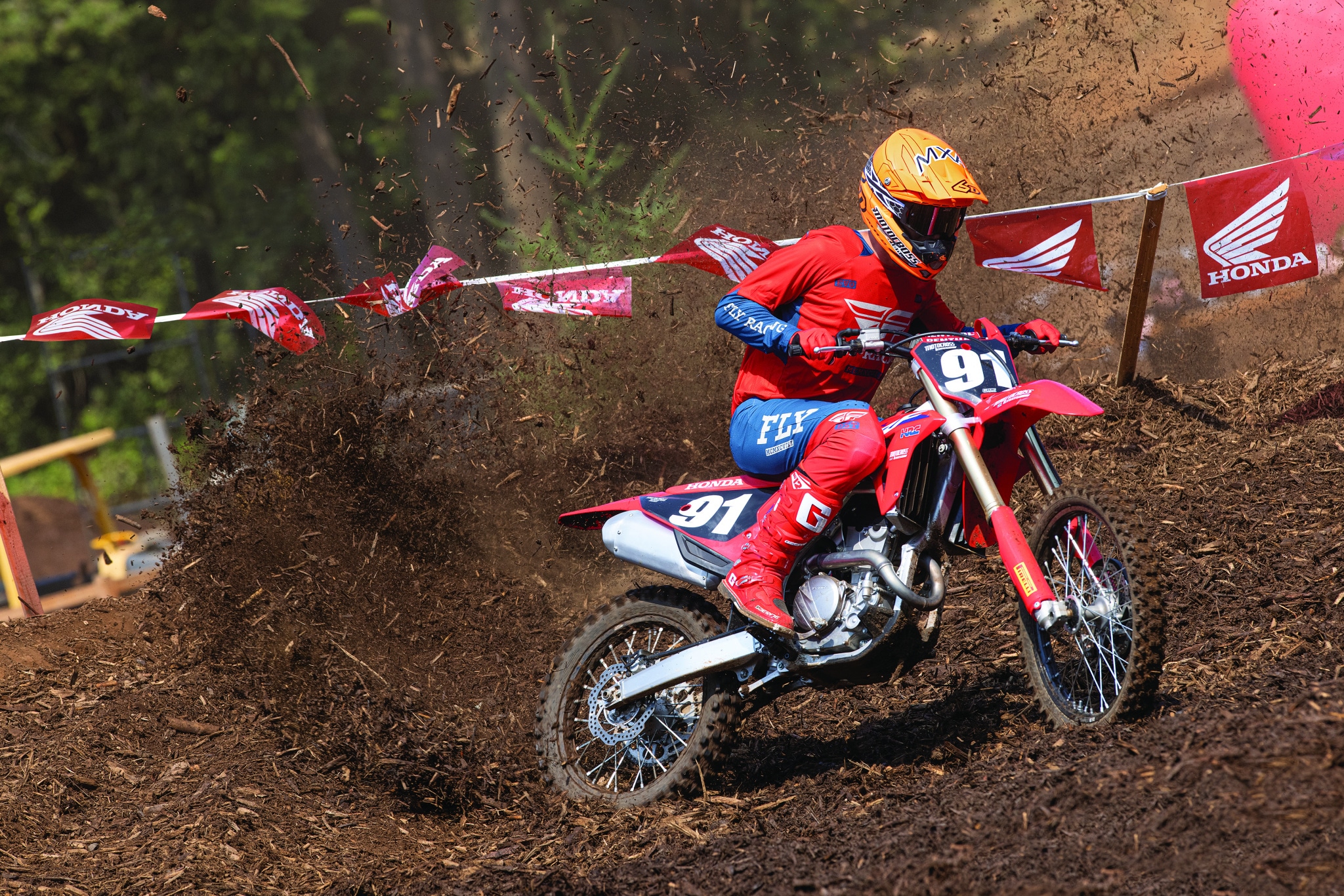 THE GEAR: Jersey: Fly Racing Evolution DST, Pants: Fly Racing Evolution DST, Helmet: 6D ATR-2, Goggles: EKS Brand Lucid, Boots: Gaerne SG12.
THE GEAR: Jersey: Fly Racing Evolution DST, Pants: Fly Racing Evolution DST, Helmet: 6D ATR-2, Goggles: EKS Brand Lucid, Boots: Gaerne SG12.
Q: FIRST AND FOREMOST, IS THE 2022 HONDA CRF250 BETTER THAN THE 2021 CRF250?
A: The CRF250 offers a laundry list of changes for 2022, but it is not all new as you have been led to believe—although it is the only totally new motocross bike of 2022 (as everyone else kept what they had with minimal updates or none at all). Honda is using the same engine as in previous years; however, numerous changes have been made to improve performance. Overall, the CRF250 is lighter, and the power characteristics have gone from a top-end-only engine to a low-to-mid engine. So, the majority of the CRF250 is light years better than the 2021 CRF250; however, HRC didn’t get everything right.
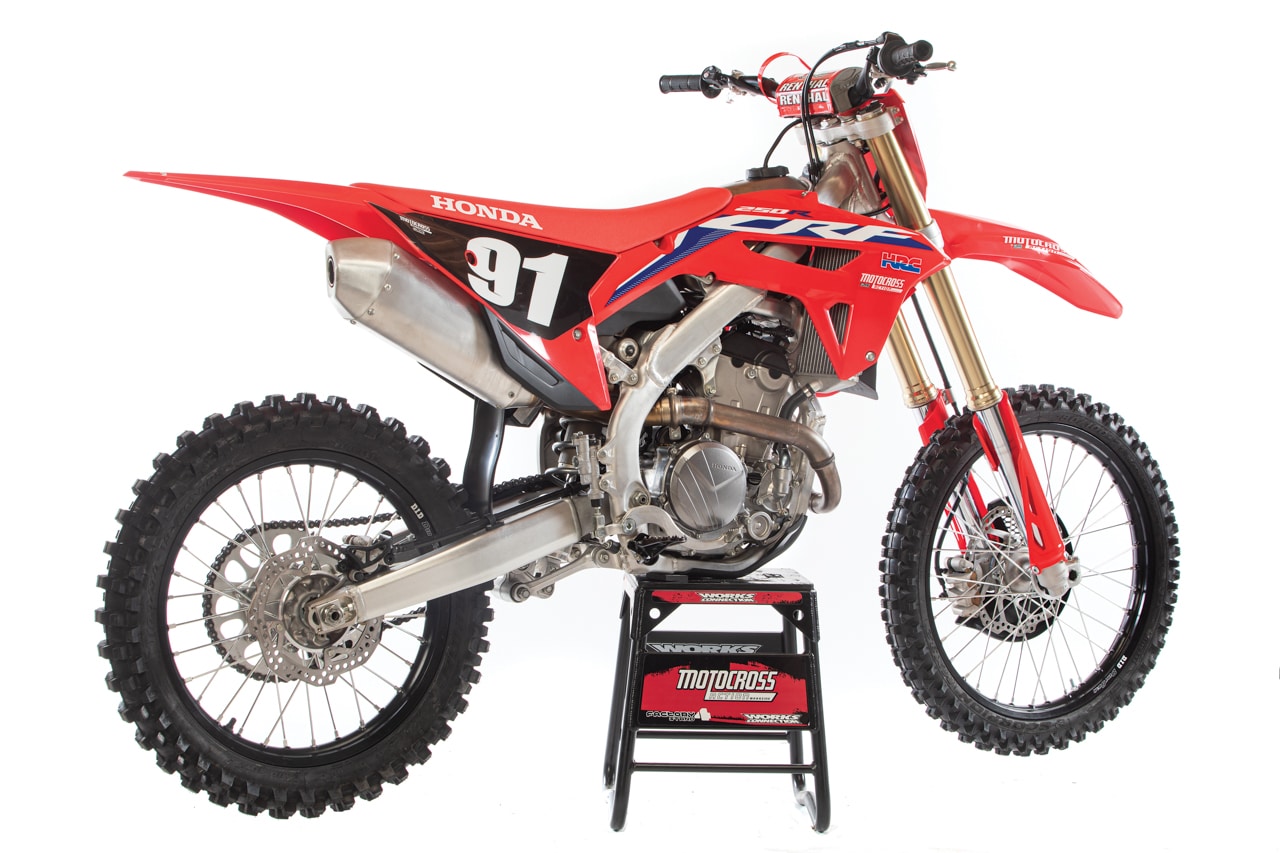 Honda shed weight and increased low-end power on the 2022 Honda CRF250.
Honda shed weight and increased low-end power on the 2022 Honda CRF250.
Q: WHAT MODIFICATIONS WERE MADE TO THE CRF250 TO CHANGE THE POWER PROFILE?
A: The Honda CRF250 was begging for help after the introduction of the 2018 CRF250. The chassis was well received by riders, but their copycat top-end-only philosophy was a step in the wrong direction. Honda dumped a truck load of money into developing the all-new twin pipe (not twin mufflers) engine that no one liked. Many said they felt as if they were dragging the rear brake around the track. It seemed fast on the dyno with its high-horsepower engine, but it just took too long to get into the meat of the power. Once it got there, the competition had already blown by. Honda did try hard to make changes that improved the CRF250 engine year over year, but they missed the mark, as the powerband, power profile and power placement weren’t good enough to compete with the heavy hitters in the class.
Honda had many goals with the 2022 CRF250, but the biggest one was to improve the powerplant. Without a potent engine in the 250 four-stroke class, you don’t stand a chance on the racetrack. Honda found they didn’t have to throw the baby out with the bath water with the engine. They didn’t change the cases, the stroke or the bore, the size of the intake or exhaust valves or the compression ratio. Honda updated vital roles on the engine package as well as the intake tract to get the most out of it. Here is what they did.
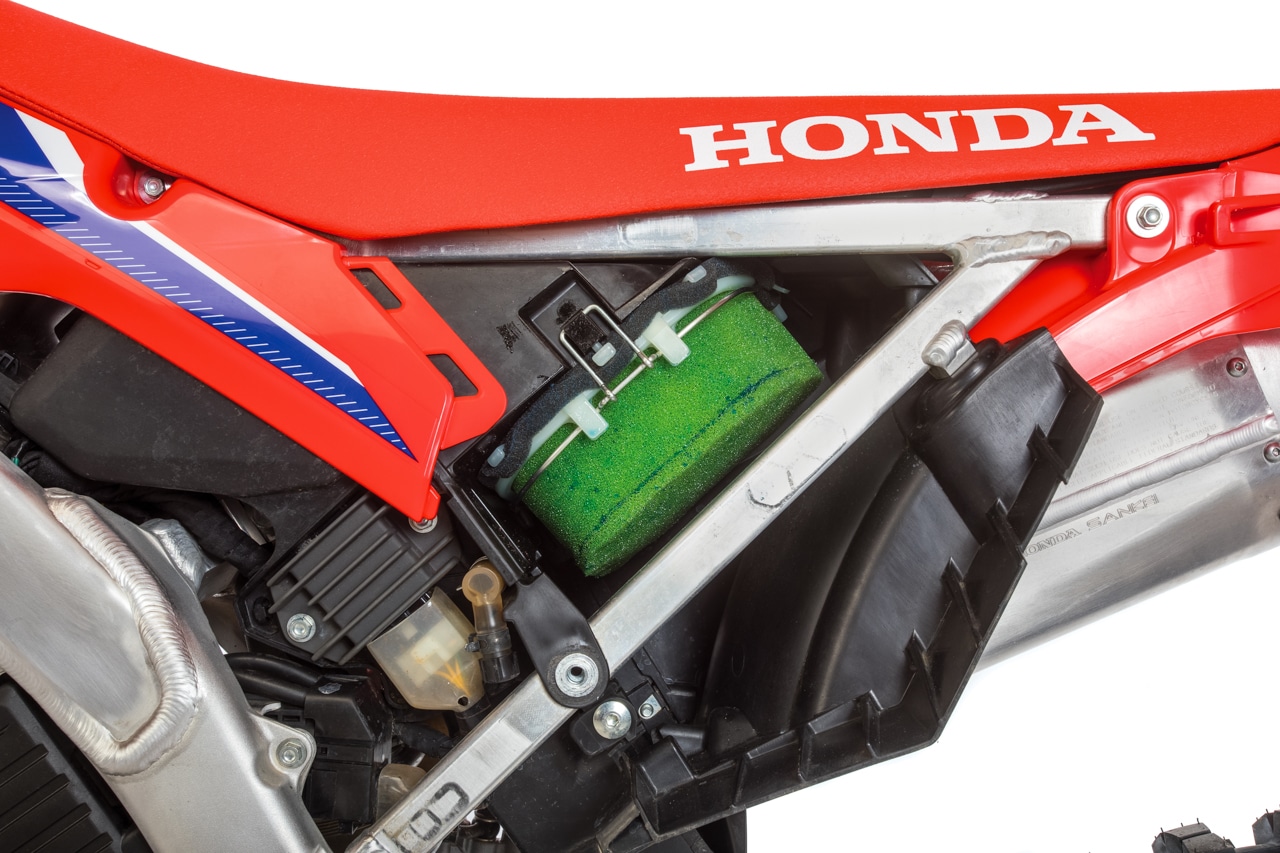 The air filter is upside down.
The air filter is upside down.
(1) Valves. Much of the focus was on the head. The titanium intake and exhaust valves remain 33mm and 26mm respectively, but the intake valves feature dual springs (one inside the other) for precise movement at higher rpm. Thanks to a new air intake, revised valve timing and a straightened exhaust port, there is a 20-percent increase in power at 6500 rpm.
(2) Camshaft. The camshaft sprocket is now press-fit on. The camshaft towers have been beefed up, and valve action at higher revs is enhanced by more oil flow.
(3) Rocker arm. The rocker-arm shaft’s alignment has been redesigned.
(4) Oil supply journal. The camshaft’s oil supply journal was redesigned to increase flow by 80 percent. This gives the engine better durability at higher rpm.
(5) Oil volume. With a change to the oil pump’s driver gear, oil volume to the cylinder head was increased.
(6) Piston. The piston is generally the same; however, the underside got structural changes to increase durability.
(7) Connecting rod. It was beefed up to improve strength.
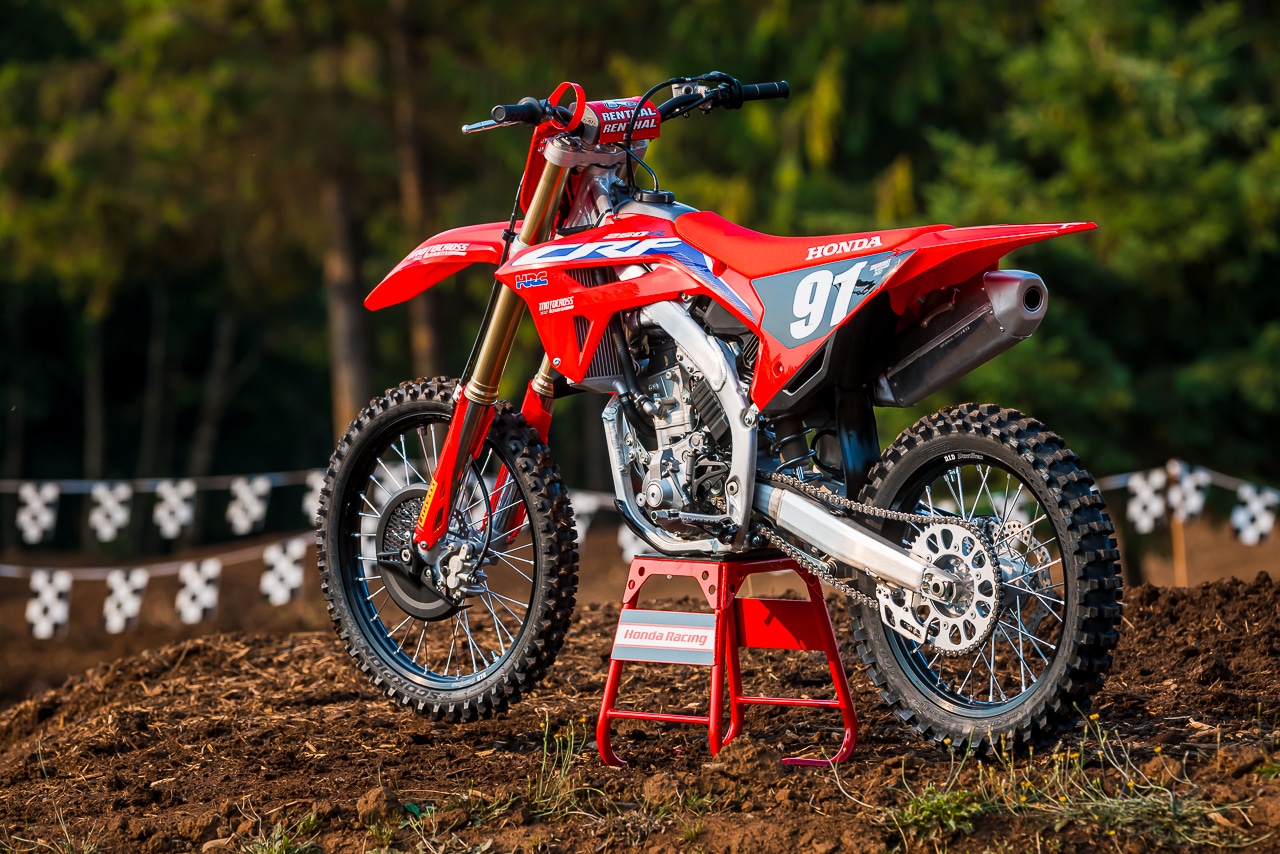
It’s been a long wait, but Honda has finally drop kicked their twice pipes. Good riddance.
(8) Exhaust. Honda finally gave up on the twice mufflers and dual exhaust ports to go back to the lighter and cheaper single-side exhaust. The exhaust port is now a center port design. The single head pipe is 74mm closer to the engine on the right side. The right and left side panels are 20mm and 50mm more inboard, respectively, for a 70mm-narrower cross section at the rear.
(9) Intake. Airbox volume has been increased 78 percent, mostly on the clean side of the air filter, and the fuel-injector lean angle was increased from 30 to 60 degrees.
(10) Clutch. The clutch pack now has nine plates instead of eight. The clutch basket is more rigid. The primary ratio is lower. Lubrication is optimized, and clutch lever pull is 4 percent lighter.
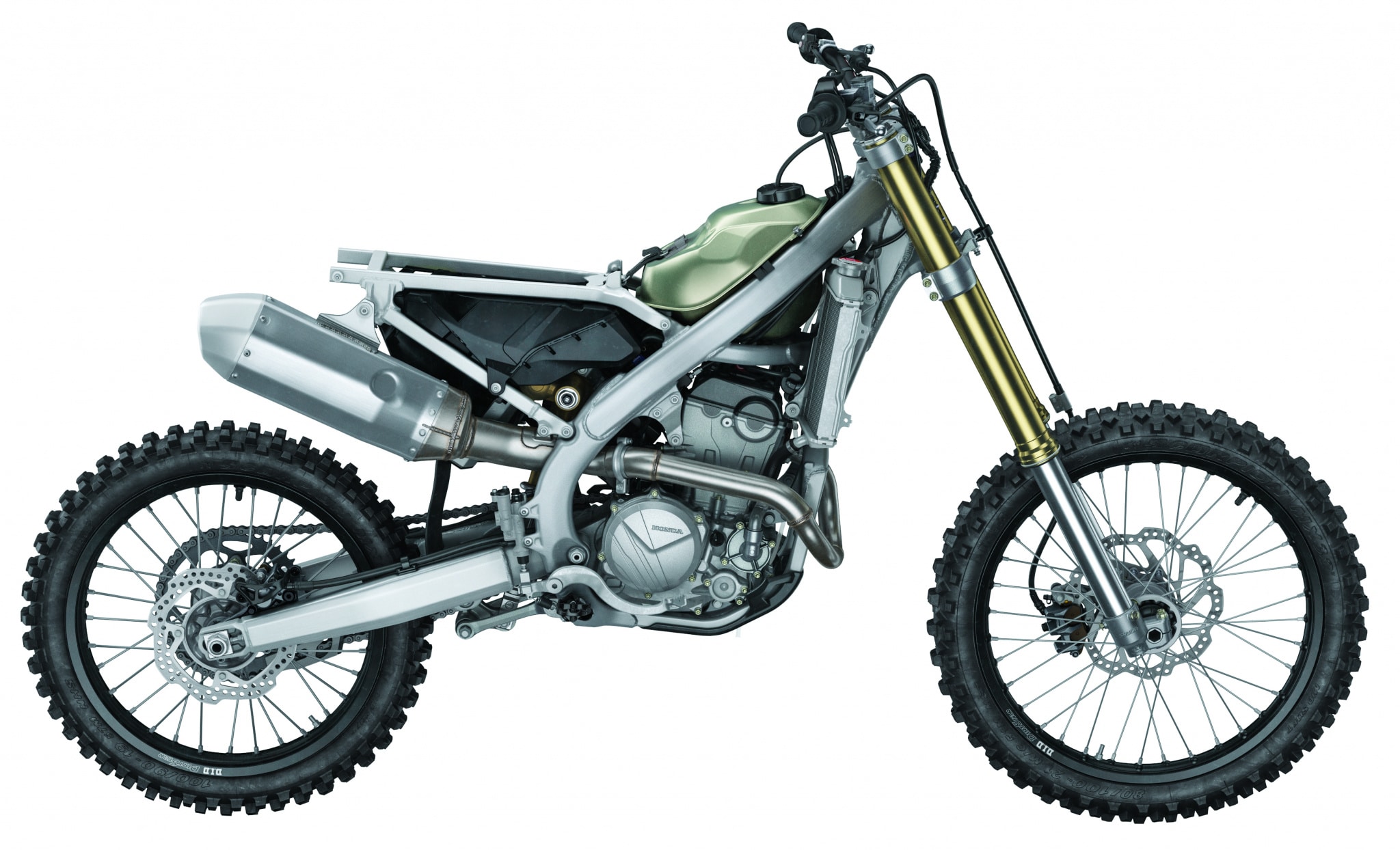 Q: WHAT OTHER BIG CHANGES WERE MADE?
Q: WHAT OTHER BIG CHANGES WERE MADE?
A: The obvious answer is the 2022 CRF250 borrowed the CRF450 chassis. This means that the frame, swingarm, subframe, shock, forks, and triple clamps are all-new for 2022. Most of the changes saved a significant amount of weight while also massaging the geometry of the bike. The wheelbase is 10mm shorter, rake is relaxed .02 degrees (at 27.32 degrees), trail remains at 115mm, and ground clearance is increased by 3mm (now 13.1 inches). The aluminum frame is 1.5 pounds lighter for 2022. Longitudinal rigidity is the same, but lateral rigidity is reduced by 20 percent to enhance handling feel when cornering.
Q: HOW FAST IS THE HONDA CRF250 ON THE DYNO?
A: On paper, the 2022 CRF250 offers less peak horsepower and torque than its predecessor. This sounds worse than it really is. Peak power is important, but it isn’t the end-all, be-all of stats. The 2022 CRF250 comes in at 41.32 peak horsepower at 11,830 rpm and 20.07 peak torque. It still ranks in the same order as last year; third to last in peak horsepower and second to last in torque.
On the dyno the CRF250 is the strongest of all the 2022 250 four-strokes from off idle to 8000 rpm, but by 9000 rpm it drops to fourth in overall power. What has improved significantly on paper over the 2021 CRF250 is the power from 5600 to 8200 rpm. It went from being last in this power rpm range to being first in its class! Impressive to say the least. After 8200 rpm, the power curve becomes more linear and there is a mysterious power dip at 9600 rpm, but the engine regains its composure and comes on strong again from 11,000 rpm to peak. It doesn’t crack the 40 horsepower mark until 11,300 rpm and it peaks at 40.69 horsepower at 11,900 rpm. It’s weak on peak horsepower with the GasGas making 44.2, KTM 44.2, Husqvarna at 44.1 and Kawasaki 43.7 and Yamaha 42.5.
To make it simple, Honda beefed up the low-end throttle response and low-to-mid power output. This changed the CRF250 from a high-rpm engine to a low-to-mid engine. This drastic change was for the better, since the previous high-rpm layout was a loser on the dyno—and couldn’t compete in the upper rpm ranges with the 250SXF, FC250, MC 250F or KX250 on the track.
Q: HOW FAST IS THE CRF250 ON THE DIRT DYNO?
A: Smooth as butter. Honda finally turned its four-year slump around with the 2022 engine. Given that Honda tried to play the high-rpm game against the high-revving KTM 250SXF, Husqvarna FC250 and Kawasaki KX250 for the last couple years to no avail, Honda’s engineers decided to mimic the YZ250F’s low-to-mid powerband. The CRF250 sounds like a YZ250F on the track and has a very similar dyno curve, but does it excel in the dirt? Yes. The CRF250’s low-end power is silky smooth through the corners, unlike the herky-jerky sensation of the YZ250F. The power transition from the crack of the throttle into the low end doesn’t miss a beat. It exits corners with authority, and there is no need to abuse the clutch.
On the dyno, the power starts to taper off as it transitions from the midrange to the top end, but on the track it doesn’t feel as though it falls off significantly. It pulls long and hard until the rev limiter kicks in. Even then, it is up to you to decide when to shift (or if you want to shift). The shift points and gearing suit the power delivery to a tee. If we wanted to be picky, we wish Honda had extended third gear by a touch; however, map 3 band-aided it for us.
The decision to clone the Yamaha YZ250F’s powerband makes the CRF250 engine a fierce competitor against the pack of high-revving wolves it faces. Now, instead of being the tail-gun Charlie of the screamers, it is the best low-to-mid power on the track, but not by much. When you completely reconfigure your powerband, you “give to get.” Honda got Yamaha-style low-to-mid power but gave up top-end power. The CRF250 is over 3 ponies off the best of the high revvers. Plus, the Husky FC250 and KTM 250SXF still offer solid low-to-mid punch and then hit the afterburners as the rpm climb. The CRF250 is an improved engine, but it’s not perfect.
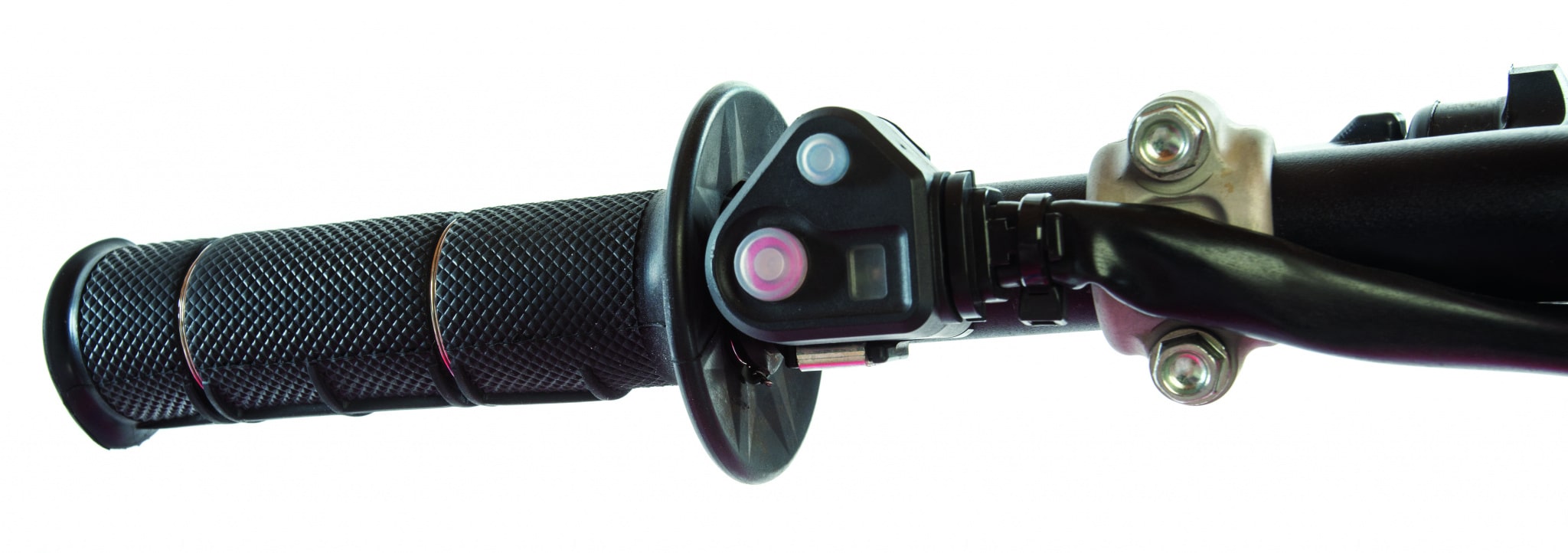 The CRF250 offers three map options.
The CRF250 offers three map options.
Q: DID THE CRF250 GO ON A DIET?
A: For 2022, the CRF250 went on a strict diet, losing 8 pounds. It shed the obnoxious dual pipes and mufflers and trimmed weight in the chassis and engine. This weight reduction brings the CRF250 down to the weight of the Husky FC250, which is third in its class following the GasGas MC 250F at 217 pounds and the 250SXF at 218 pounds. It is now tied with the Husky at 219 pounds. This is a big improvement, as the lightness can be felt on the track. Kudos to Honda for finally realizing that weight does make a difference.
Q: ARE THE SHOWA SUSPENSION COMPONENTS AS GOOD AS LAST YEAR’S?
A: No. The 2021 CRF250’s suspension was great for the smaller target demographic of the 250 class—which is young lightweight riders. The 2021 CRF250 suspension was simple to set up for virtually any rider and was confidence inspiring on the track. It had a great initial setting. We admit that the 2021 CRF250 forks weren’t perfect for all riders. They were on the soft side for Pro riders and would dive coming into corners on occasion; however, no fork is perfect for all sizes and skill levels. In 2021, Honda got the suspension formula right for about 90 percent of the CRF250 demographic, but threw all of that out the window in 2022. Honda’s R&D department listened to the wrong test riders and complied with the wishes of Pro riders who complained that the 2021 Showa forks were too soft, so they stiffened them—by a lot. We had hoped the 2022 Honda CRF250 would take another page out of Yamaha’s playbook and refine what was already a good setting for their forks; instead, they threw the baby out with the bathwater.
The Showa forks are the worst part of the 2022 Honda CRF250. The forks make the CRF250 extremely hard to set up. We did everything we could in an effort to make the forks feel plush, but we couldn’t do it. We were told that the shock spring was too soft, which made the rear ride too low, which in turn took weight off the forks. It is true that the 2022 shock spring is softer than last year. We tried to help the forks by stiffening up the rear end, but that didn’t have much effect on the forks, and it only succeeded in making the shock worse.
The forks initially ride high in their stroke, and the front end wants to dance around coming into corners. The biggest problem for every MXA test rider was that the forks wanted to work for the first half of the stroke and then they hit a wall of damping that was jarring. We asked Showa to lower the oil height to try to move the hard spot further down in the stroke, but they didn’t want to go as far as we did. After Showa lowered the oil height by 5cc, we took over and lowered the oil height by 20cc. With this change, the bike had a better balance from front to rear, and the front end rode lower in the stroke, which let it turn with greater precision. Lowering the oil height helped the CRF250 carve through the corners.
In all honesty, though, lowering the oil height didn’t solve the harshness issue. In stock trim, the stock Showa forks will only work for a small percentage of riders. The faster you are, the better chance you have of loading the forks hard enough to break through the harshness, but for the majority of our wide range of test riders, the 2022 Honda CRF250 forks were not popular.
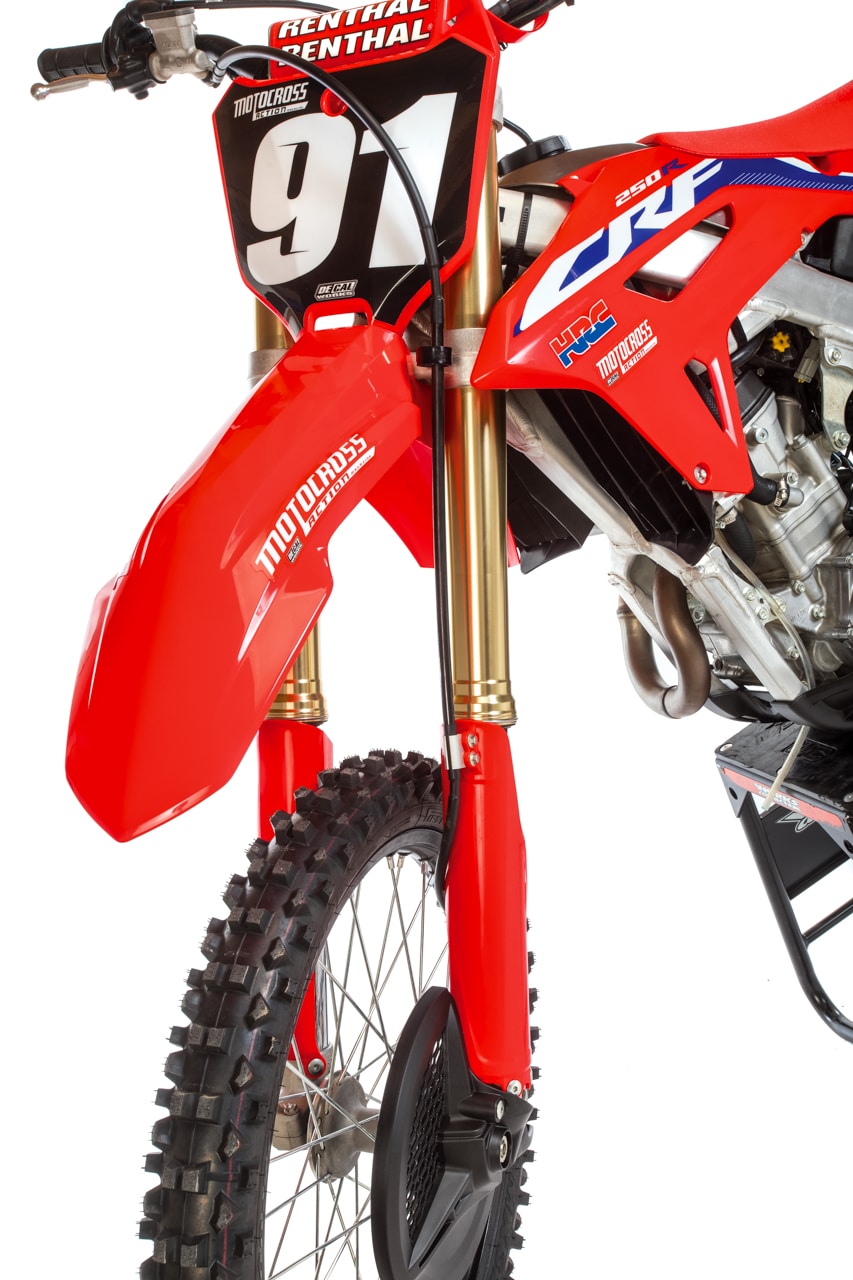 Honda dropped the ball on the fork valving. It is very harsh at the end of the stroke.
Honda dropped the ball on the fork valving. It is very harsh at the end of the stroke.
Q: WHAT DID WE THINK OF THE PIRELLI TIRES FRONT AND REAR?
A: The Pirelli tires shaved 2 pounds off the 2022 CRF250 in comparison to Dunlop MX33 rubber. Honda magnified the weight savings by spec’ing a super-narrow 100/90-19 Pirelli Mid-Soft on the rear. The only legitimate reason for this seriously under-sized rear tire was to bring the weight down to that of the three Austrian steeds; however, the CRF250 makes too much low-to-mid power for such a narrow tire. The teeny-weeny contact patch broke loose when test riders got on the gas on the exit of corners. We swapped out the little Pirelli for a bigger 110/90-19 Dunlop MX33. The bigger footprint calmed the rear end down. We don’t blame the Pirelli Scorpion Mid-Soft tires as much as Honda spec’ing a tire size better suited to a CR125 than a 41-horsepower CRF250.
The front Pirelli tire worked well, but we had to add 1 to 2 pounds more air than we would normally run on a Dunlop (approximately 14 psi) to keep the side walls from flexing. When we eventually switched to a Dunlop MX33 front, we could run whatever air pressure we wanted, and the tire was more consistent.
Q: DID WE LIKE THE ERGOS?
A: Loved them! Honda hit the nail on the head again in 2022. This has been the most comfortable bike to ride for the last few years.
Q: HOW WERE THE THREE DIFFERENT MAPS?
A: We liked that each of the three maps had a unique feel. Map 1 (one flash) was the broadest map, as well as the most popular among MXA test riders. Map 2 (two flashes) was a mellower map for slick conditions. Map 3 (three flashes) had more low-to-mid punch. Some of MXA’s Pro-level riders chose Map 3, as they felt it was the fastest; however, it did cost some over-rev and force the rider to shift on the bubble.
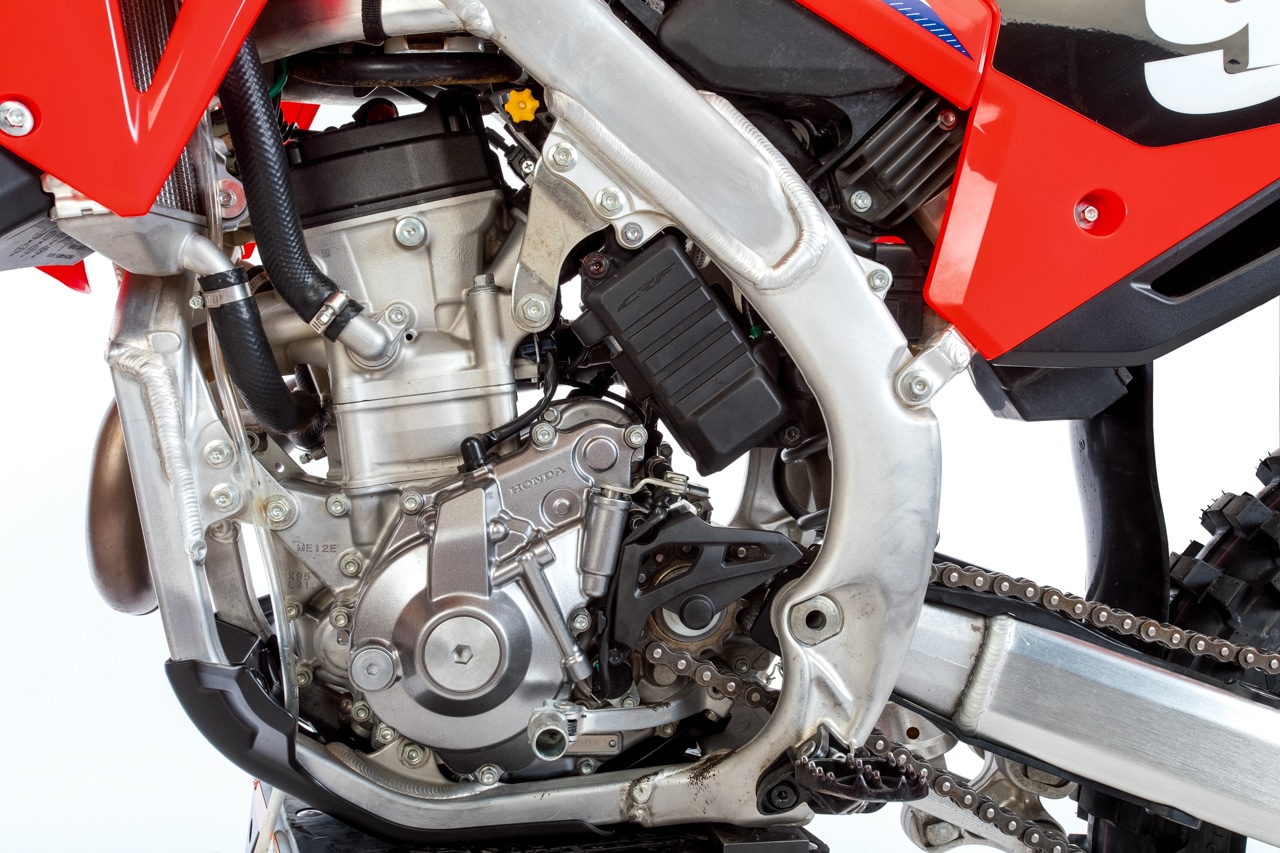 The 2022 CRF250 powerplant may not produce as much peak power as the 2021 CRF250, but the engine is much stronger from low to mid.
The 2022 CRF250 powerplant may not produce as much peak power as the 2021 CRF250, but the engine is much stronger from low to mid.
Q: WHAT DID WE HATE?
A: The hate list:
(1) Forks. The 49mm Showa forks feel good for the first half of their travel but get stiffer the farther they move. They exhibit a horrible harsh spot in the last 4 inches of travel. We don’t think there is a good shade-tree fix. You will most likely have to send them out for a re-valve ASAP.
(2) Tires. What is a 125cc rear tire doing on a 250 four-stroke? We put our favorite Dunlop 110/90-19 on to fix the issue. We also switched out the Pirelli front for a Dunlop MX33.
(3) Grips. These stock grips are bulky and hurt your hands.
(4) Side shrouds. The right-side radiator shroud blocks access to the radiator gap. We struggle with the shroud to get the cap off.
(5) Vent hose. The gas cap vent hose is too short. When we take the gas cap off, the hose falls off.
(6) Airbox vents. We like that the CRF250 has a big vent in the airbox so the engine can breathe, but the CRF250’s upside-down air filter gets dirty faster than any other bike.
(7) Balance. Just as with the quirky CRF450 chassis, we got dizzy trying to find a good fore and aft balance. A change to the front ruins the rear and vice versa.
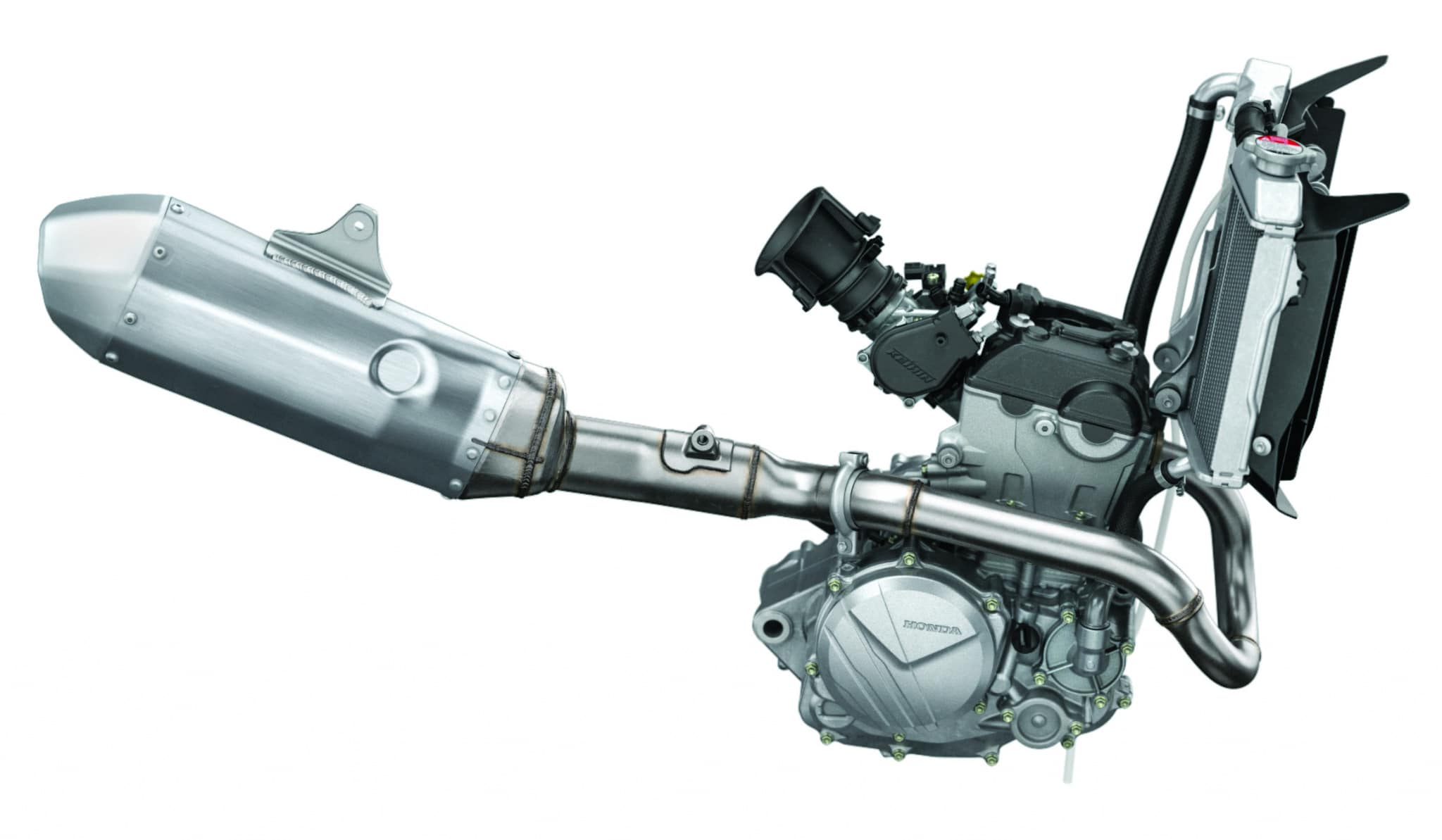
Honda claims an 8-pound weight savings, which gets their weight (without gas) down to 220 pounds. The weight savings come courtesy of the CRF250 losing one exhaust port on the cylinder, one exhaust pipe and muffler on the left side of the bike, a lighter shock spring, and the shift drum is now 17 percent lighter.
Q: WHAT DID WE LIKE?
A: The like list:
(1) Engine. This is by far the best low-to-mid engine. Test riders called it “a faster YZ250F.”
(2) Ergos. No bike feels as comfortable as the CRF250. Everything falls in place like it was designed personally for you.
(3) Maps. Each map was distinctly different and had a purpose.
(4) Tank. The titanium tank looks great when it isn’t covered up by plastic cladding.
(5) Weight. The CRF250 is the first Japanese bike to compete with the Austrians in the weight department. It weighs 1 pound more than the KTM 250SXF but 3 pounds more when you change the rubber.
(6) Clutch. Even though Honda hasn’t gone to a hydraulic system yet, the CRF250 clutch could take a beating. Just be sure to check the lever’s freeplay before every moto.
(7) Brakes. The brakes had great modulation and worked well.
Q: WHAT DID WE REALLY THINK?
A: Over the last four years, Honda has been on the cusp of having excellent 250 four-strokes, only to have its sourpuss engines ruin all the goodness. Finally, in 2022, Honda made a CRF250 four-stroke engine that is worthy of the rest of the bike (save for the front forks). In our 250 shootouts, we have often said, “The Honda CRF250 would win this shootout if it had a KTM engine in its superb layout‚ but it doesn’t.” Now, Honda has an engine that honors the Honda name. Yes, the poorly executed forks throw off the entire handling of the bike, but bad forks can be fixed more easily than bad engines—and for a lot less money. Once you push the forks into a UPS truck and send them to your favorite suspension tuner, the 2022 Honda CRF250 offers a great package.
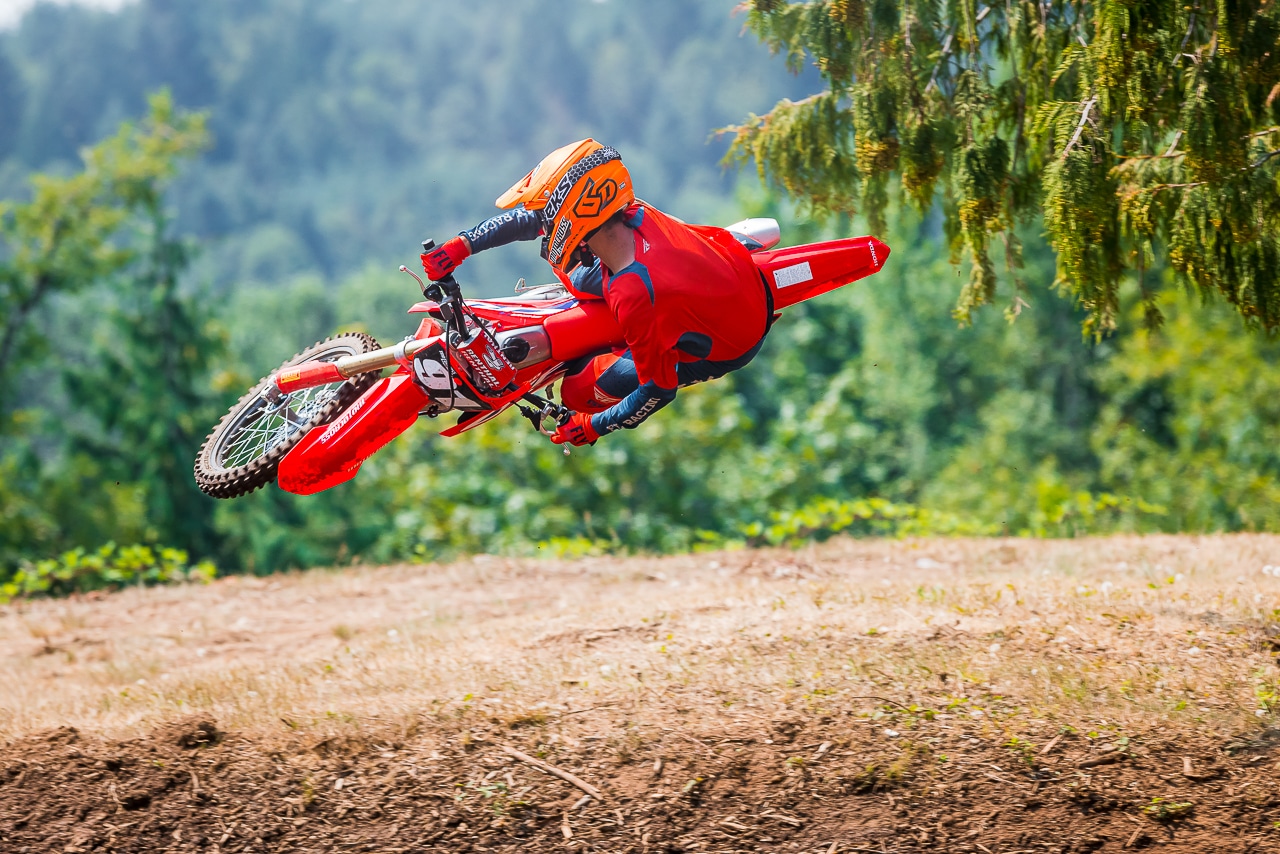 The CRF250 is a very fun and agile bike to ride.
The CRF250 is a very fun and agile bike to ride.
MXA’S 2022 HONDA CRF250 SETUP SPECS
This is how we set up our 2022 Honda CRF250 for racing. We offer it as a guide to help you find your own sweet spot.
SHOWA SPRING FORKS
These forks are just about impossible to get right in stock trim. They start out good because they ride higher in their stroke than before, but soon after that they hit a harsh spot that you just can’t get around. On a positive note, we couldn’t bottom them. We lowered the fork oil height in increments—settling on 20cc. This allowed the bike to turn much better and softened up the initial part of the stroke, but could not solve the harshness at the end of the stroke completely. Expect to budget a bundle for your personal suspension guru. For hardcore racing, these are MXA’s recommended 2022 CRF250 fork settings (stock settings are in parentheses):
Spring rate: 4.8 N/mm
Compression: 7 clicks out (12 clicks out)
Rebound: 11 click out (13 clicks out)
Fork-leg height: 5mm
Notes: Be forewarned that the Showa forks are sensitive to just one click. When you make adjustments, keep in mind that changes to the front affect the rear and vice versa.
SHOWA SHOCK SETTINGS
The rear suspension system received a revised rising-rate ratio to work with a Showa shock absorber whose shape has changed to fit the new frame, with adjusters moved from the left side to the right. The ultra-light steel shock spring is a 1/4 pound lighter than last year. The shock was good for the majority of our test riders with the stock settings. Depending on the weight of the rider, we lowered or raised the in-motion ride height by adjusting the high-speed compression. For hardcore racing, these are MXA’s recommended 2022 CRF250 shock settings (stock settings are in parentheses):
Spring rate: 50 N/mm
Race sag: 105mm
Hi-compression: 2-1/4 turns out (2-1/6 turns out)
Lo-compression: 6 clicks out
Rebound: 9 clicks out (11 clicks out)
Notes: The spring rate is softer than last year. If you are around 200 pounds, a 52 N/mm spring might be the answer. A word to the wise, send in your forks to your favorite suspension shop before touching the shock.
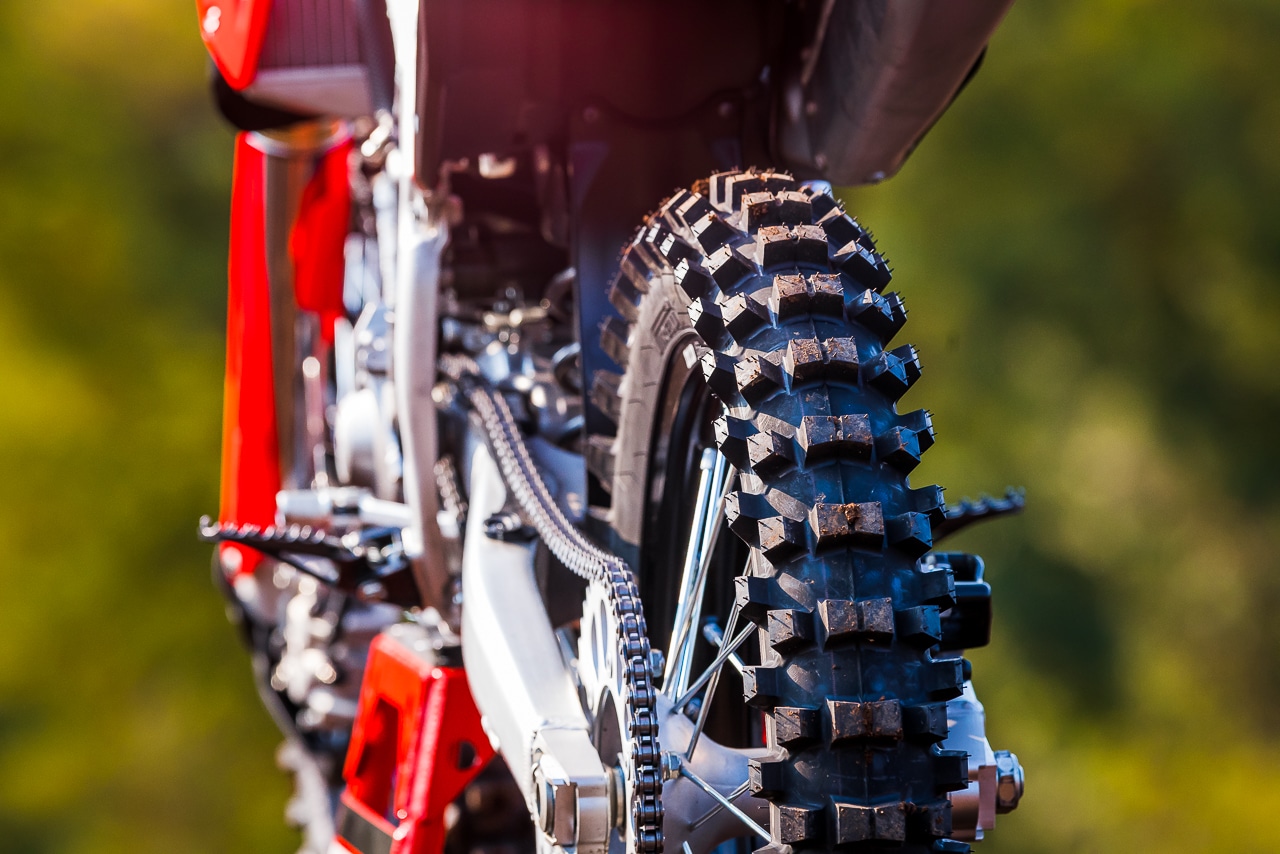 The Pirelli Scorpion MX32 tires helped Honda drop some weight on the production model CRF250.
The Pirelli Scorpion MX32 tires helped Honda drop some weight on the production model CRF250.


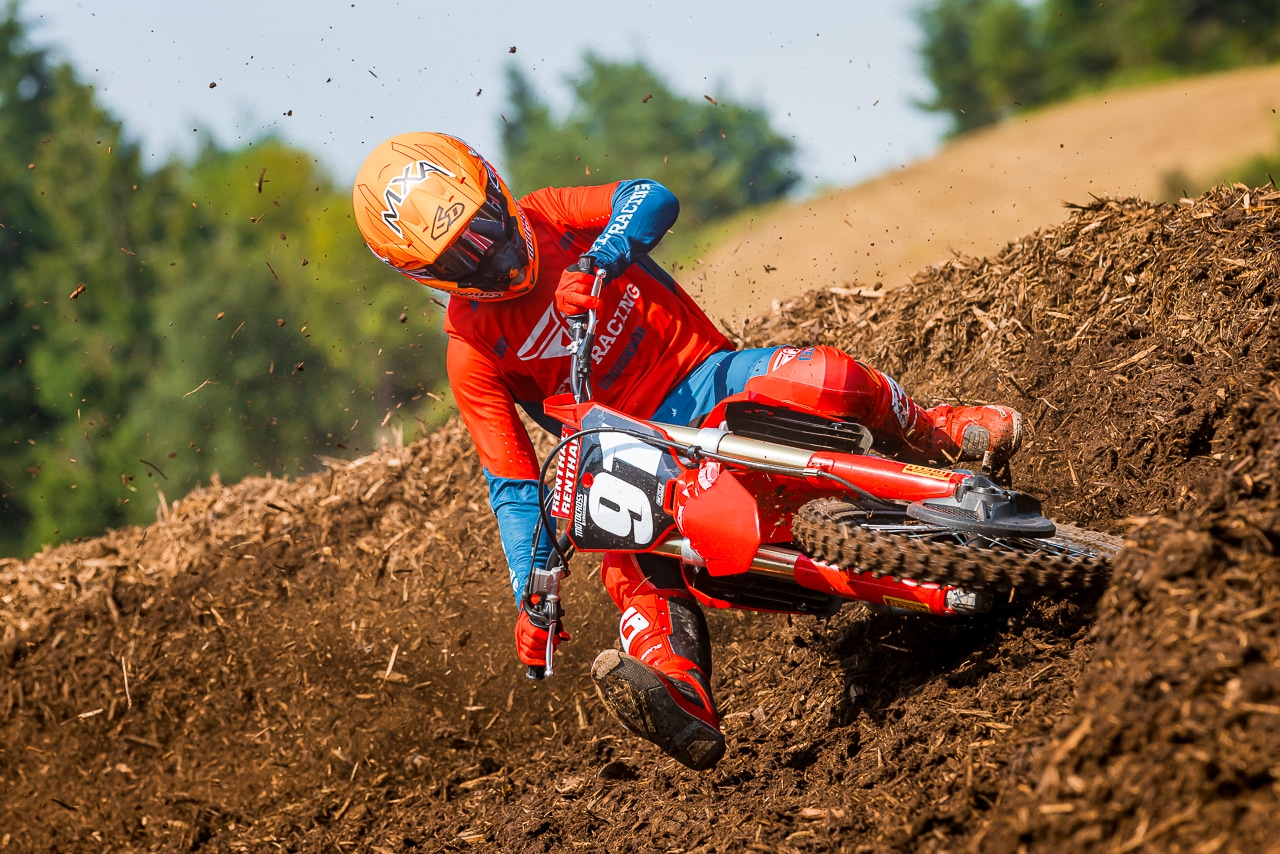
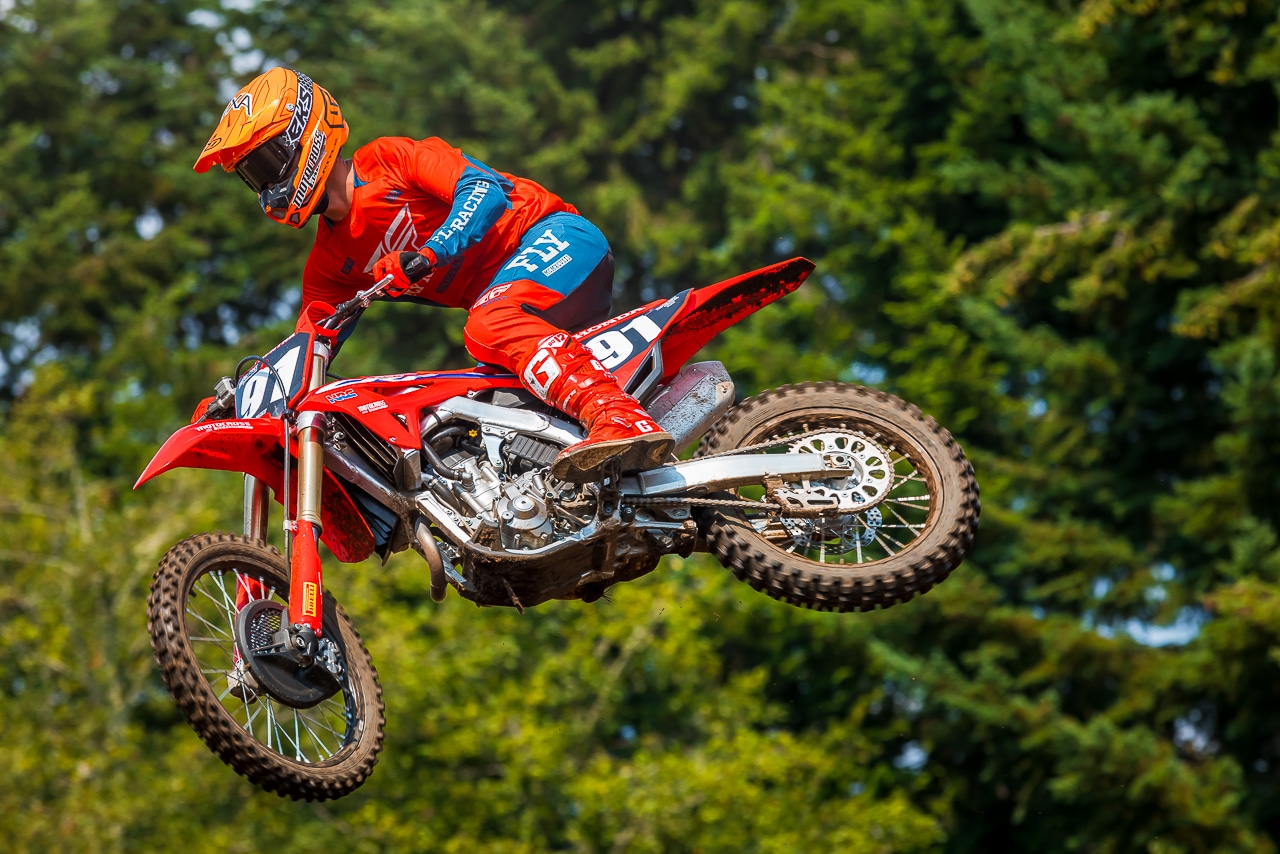




Comments are closed.